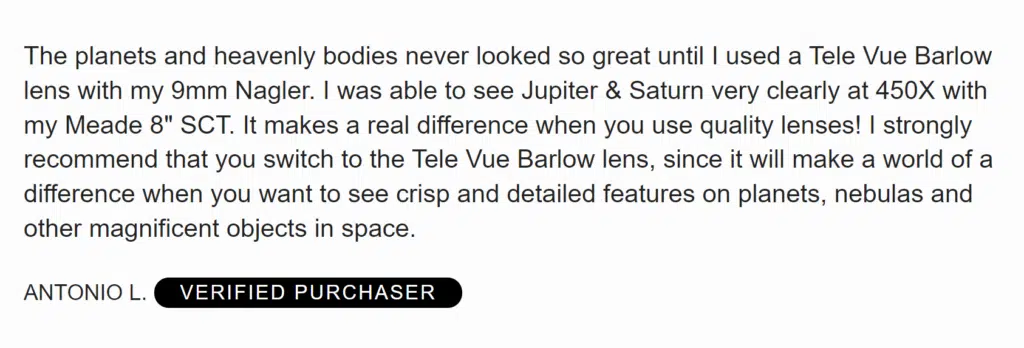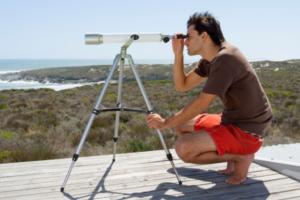6 Best Barlow Lenses Of 2025 (2x & 3x): Reviewed
Disclosure: This post contains affiliate links and I may earn a small commission (at no extra cost to you) if you click through and make a purchase. Thanks in advance – I really appreciate it!
A good Barlow lens is the key to building a solid collection of eyepieces without breaking the bank. It is one of the most important purchases you can make to improve your viewing sessions as it will give you instant access to double the magnification options you had before.
For instance, if you have a 30mm, 24mm, and 10mm eyepiece, having a Barlow in your collection effectively adds a 15mm, 12mm, and 5mm eyepiece to your collection.
Since one decent Barlow lens is much cheaper than three new eyepieces, it is really cost-effective.
So I took some time and reviewed 6 top Barlow lenses and stated their respective pros and cons below.
Our Top Pick
Celestron X-Cel LX 1.25-Inch 3x Barlow Lens
- Quality X Cel LX 3x Barlow triples the magnification of any 1.25 inch eyepiece, perfect for owners of fast, short focal length telescopes
- 3 element apochromatic, fully multi coated optics offer up bright, sharp images with excellent color correction
- A rubber grip helps to avoid accidental drops
- Barrel is threaded to accept standard 1.25 inch filters
- A brass compression ring holds eyepiece firmly in place
Prices pulled from the Amazon Product Advertising API on:
Product prices and availability are accurate as of the date/time indicated and are subject to change. Any price and availability information displayed on [relevant Amazon Site(s), as applicable] at the time of purchase will apply to the purchase of this product.
The Celestron X-Cel LX 3x Barlow Lens is a 1.25-inch apochromatic lens that triples the magnification of your eyepiece. It is one of the most popular Celestron Barlow lenses used by astronomers for astrophotography, owing to its great price and exceptional value. Users of this high-quality Barlow lens say that it produces images that are breath-taking, beautiful, and crisp, with highly satisfying contrasts.
Best Barlow Lenses (2x & 3x)
| Image | Title | Price | Buy |
|---|---|---|---|
 Top
Top | Celestron 93428 X-Cel LX 1.25-Inch 3x Barlow Lens | See on Amazon | |
 Top
Top | SVBONY Barlow Lens 2X 1.25 inch | See on Amazon | |
 Top
Top | Celestron Omni 2X Barlow Lens | See on Amazon | |
 Top
Top | Televue 2x Barlow 1.25 inch (1-1/4 in.) | See on Amazon | |
 Top
Top | Zhumell 2" 2x ED Barlow Lens with 1.25" Adapter | See on Amazon | |
 | Orion High-Power 2 Inch 2x 4-Element Barlow Lens | See on Amazon |
Product prices and availability are accurate as of the date/time indicated and are subject to change. Any price and availability information displayed on [relevant Amazon Site(s), as applicable] at the time of purchase will apply to the purchase of this product.
Prices pulled from the Amazon Product Advertising API on:Top Barlow Lenses - Reviews
1. Celestron X-Cel LX 1.25-Inch 3x Barlow Lens
- Quality X Cel LX 3x Barlow triples the magnification of any 1.25 inch eyepiece, perfect for owners of fast, short focal length telescopes
- 3 element apochromatic, fully multi coated optics offer up bright, sharp images with excellent color correction
- A rubber grip helps to avoid accidental drops
- Barrel is threaded to accept standard 1.25 inch filters
- A brass compression ring holds eyepiece firmly in place
Prices pulled from the Amazon Product Advertising API on:
Product prices and availability are accurate as of the date/time indicated and are subject to change. Any price and availability information displayed on [relevant Amazon Site(s), as applicable] at the time of purchase will apply to the purchase of this product.
This high-powered Barlow lens is perfect for astronomical observation, especially with short focal length telescopes.
Its fully multi-coated 3-element apochromatic design offers color correction and superior sharpness for optimal images.
With a twist-up eye guard, the 3x X-Cel Barlow lens was specifically designed for comfort and ease of use.
This eyepiece has a wide 60° field of view. The Celestron 3x X-Cel LX Barlow lens triples the magnification of your current eyepiece, making it perfect for short tube telescope owners who are looking for more power in their lunar or planetary views.
If you’re trying to get a detailed view of the moon or other planets, but your telescope isn’t quite powerful enough even with an eyepiece, then this might make the difference. It’s very simple and easy to use, and it’s a well-made piece of equipment.
The X-Cel LX even features a rubber grip that will help avoid accidents and falls that as you can imagine, can be fatal for optic instruments.
This Barlow lens is offered in 2x and 3x magnifications, but I recommend going for the 3x version.
Pros
- Great build quality
- Good optical quality in this price range
- Fully multicoated surfaces
- Exterior has a hard-anodized coating with a burly rubber grip
Cons
- None
2. SVBONY 1.25-inch Barlow Lens 2X
- 1.25 2x Barlow lens fully multi coated metal with M42x0.75 thread camera connect interface for telescope eyepieces
- Barlow lens 2x double the capacity of an existing set eyepiece;give a big magnification boost to any 1.25 eyepiece its used with
- The housing is precision machined from aluminum stock and black anodized to a hard finish
Prices pulled from the Amazon Product Advertising API on:
Product prices and availability are accurate as of the date/time indicated and are subject to change. Any price and availability information displayed on [relevant Amazon Site(s), as applicable] at the time of purchase will apply to the purchase of this product.
If you’re looking for a cheap Barlow lens that performs reasonably well then look no further than the SVBONY 1.25-inch 2x Barlow Lens.
With most budget Barlow’s, there is always the risk of quality being compromised. However, this one from SVBONY offers good optic quality for a reasonable price without burning a hole in your pocket.
The materials and build quality for this lens are OK as the compression ring, thread, anodized black aluminum body are crafted quite well considering its low price.
The optics are good too. Just don’t expect this to offer you the most high-quality optics in the market. It does have many limitations.
Overall, this Bralow altogether provides good value for money for someone who is just starting out in astronomy or as a secondary alternative for an experienced stargazer.
Pros
- Great value for money
- Good build quality
- Threaded for filters
Cons
- Noticeable optic aberrations
3. Celestron Omni 2X Barlow Lens
- Double the magnification of each eyepiece you own with the Omni 2X Barlow Lens
- Keep the eye relief of your eyepieces while getting 2X the power
- Slides into 1.25 inch focuses and diagonals and accepts 1.25 inch eyepieces
- Fully multicoated optics with blackened edges for good light transmission and minimal reflections
Prices pulled from the Amazon Product Advertising API on:
Product prices and availability are accurate as of the date/time indicated and are subject to change. Any price and availability information displayed on [relevant Amazon Site(s), as applicable] at the time of purchase will apply to the purchase of this product.
The Celestron Omni 2x Barlow is a solid purchase for beginner astronomers and enthusiasts. This is an accessory that is going to last you a lifetime if you take good care of it which makes it worth the slightly higher price above similarly specced Barlows from other brands.
Its multicolored optics produce color-saturated and contrasted pictures without any hint of aberration.
Also, it’s compatible with any 1.25’ eyepiece, filter, and diagonal.
The Barlow has fully multi-coated optics with blackened edges and it maintains a comfortable eyepiece eye relief. The eyepiece relief is the distance between your eye and the lens.
Comparing its quality and price with other counterparts, we would say it provides a much better trade-off and cost-efficiency.
If you’re in search of your first Barlow lens and your telescope is not really that powerful to justify one of the more expensive Barlows, then you can close your eyes and just choose the Celestron Omni 2x. You won’t regret it.
Pros
- Great optics for an entry-level price
- Robust build quality
- Comfortable eye relief
- Affordable and budget-friendly
Cons
None considering its price
4. Televue 2x Barlow 1.25 inch
- Tele Vue 2x Barlow Lens, 1.
Prices pulled from the Amazon Product Advertising API on:
Product prices and availability are accurate as of the date/time indicated and are subject to change. Any price and availability information displayed on [relevant Amazon Site(s), as applicable] at the time of purchase will apply to the purchase of this product.
This is a premium quality long Barlow lens measuring 97mm, but only 41mm extends out of the focuser when fitted.
The main upper barrel is black, the central 1.25-inch barrel is silver and the lower lens housing is black. This lens section is threaded to accept standard filters.
It is fully multicoated, with blackened lens edges and internal anti-reflection threading for excellent contrast.
Despite being an achromatic system, good design gives it better color correction at the edges of the field than some 3-element “apochromatic” Barlows.
The quality of the view is impressive, with virtually no distortion near the edges of the field.
Most users of this Barlow lens are extremely satisfied with it and they can not stop raving about the views of the night sky that they get using the Televue 2x Barlow lens.
Here’s a direct quote from a verified user of this Barlow lens which I found on adorama.com.

That said, I would only recommend this Barlow lens if you have the equally premium eyepieces to match it as well as a moderately powerful telescope.
You will not be able to use this Barlow lens the way it’s designed to be used if you pair it with lesser quality components.
Pros
- Premium quality Barlow lens
- Excellent optics & extraordinary views
- One of the best Barlows in the market
Cons
- Looks ordinary
5. Zhumell 2" 2x ED Barlow Lens
- Extra low Dispersion glass for sharper views
- Double the magnification of any eyepiece, both 2” and 1.25”
- Brass compression ring Adapter is gentle on eyepie
Prices pulled from the Amazon Product Advertising API on:
Product prices and availability are accurate as of the date/time indicated and are subject to change. Any price and availability information displayed on [relevant Amazon Site(s), as applicable] at the time of purchase will apply to the purchase of this product.
The Zhumell 2” ED Barlow Lens doubles the magnification of any 2” or 1.25” eyepiece, giving you the most bang for your buck.
This Barlow lens uses two-element, fully-multicoated lenses made from special ED (Extra-Low Dispersion) glass for excellent color correction and sharpness.
The lens edges are blackened to maximize image contrast. The clear aperture is 37mm so you can use even 2″ wide-angle eyepieces without vignetting.
The Barlow lens body is made from aluminum and has a premium finish that you would usually find on higher-priced items.
The Barlow comes with a 2″-1.25″ adapter so it can be used with 1.25″ or 2″ eyepieces. The Barlow tube and the 1.25″ adapter both feature brass compression rings so the set-screw will not scratch your eyepiece barrels.
The Zhumell 2x Barlow represents the perfect addition to any eyepiece collection. Once you’ve used it, this will become abundantly clear.
Pros
- Effective color aberration reduction
- Good quality construction
- Comes with a 1.25″ adapter
Cons
No instruction manual
6. Orion 2-inch 2x 4-Element Barlow Lens
- This big, 4-Element 2x Barlow will give your 2 inch telescope eyepieces a power-doubling magnification boost
- Sophisticated fully multi-coated, 4-element lens design renders exquisite images without introducing additional chromatic aberration for crisp, color-correct views
- Enjoy twice the power while maintaining comfortable eye relief and edge sharpness of longer focal length 2 inch eyepieces
- Included step-down adapter allows use with both 2 inch and 1.25 inch size eyepie
Prices pulled from the Amazon Product Advertising API on:
Product prices and availability are accurate as of the date/time indicated and are subject to change. Any price and availability information displayed on [relevant Amazon Site(s), as applicable] at the time of purchase will apply to the purchase of this product.
This big 2″ Barlow lens will give your 2″ telescope eyepieces a 2x magnification boost with amazing image quality.
The Orion High-Power 2″ 2x 4-Element Barlow Lens provides superior performance compared to standard Barlow lenses thanks to its deluxe features and 4-element design which minimizes chromatic and spherical aberrations while preserving image sharpness and contrast.
The compression ring and thumbscrew adjustment work very well in securing your eyepiece. If you use a 25-mm eyepiece with this Barlow, you get a magnification equal to a 12.5-mm eyepiece without losing any light from the aperture.
This Barlow can be used with longer focal length eyepieces to obtain a more comfortable view with better eye relief and edge sharpness than a lower focal length eyepiece since lower focal length eyepieces normally have smaller eye lenses to peer through.
It is an overall excellent Barlow lens to help expand the ability of your telescope.
Pros
- 4-element multi-coated lens
- Maintains comfortable eye relief
- Can be used with both 2-inch and 1.25-inch eyepieces
Cons
- Some may find it pricey.
Frequently Asked Questions (FAQs)
What Is A Barlow Lens?
Barlow lenses are a cost-effective way to increase the magnification of your eyepieces.
It was invented in the 19th century by mathematician/astronomer Peter Barlow.
Barlows contain a concave lens that is placed between your telescope’s objective lens or mirror and eyepiece. (Actually, they contain more than one glass element to reduce chromatic aberration).
Their effect is to increase the magnification of any eyepiece used with them, usually 2 or 3 times. As you’d expect, a 2x Barlow doubles your eyepiece magnification, whilst a 3x trebles it.
When should you buy a Barlow lens?
A Barlow lens is an easy way to increase the magnification of your telescope and using a Barlow lens effectively doubles the number of eyepieces that you have in your collection.
This means that whenever you want a greater variety of magnification options without buying multiple eyepieces or another telescope, you should just go ahead and buy a Barlow lens instead.
How does an achromatic Barlow lens work?
If we say a Barlow lens is achromatic, it means it is composed of two lenses stuck together and become one. It is mostly a combination of convex and concave lenses.
The overall result is an enhanced performance by effectively reducing chromatic aberration or splitting of colors and lights in various directions.
An achromatic lens for a Barlow means is made with at least two lenses. While apochromatic Barlows typically have three or more lenses.
Can you stack Barlow lenses?
Yes! you can stack Barlow lenses on one another provided they are the same barrel size (1.25″ or 2″) and the maximum useful magnification according to your telescope’s aperture size and the focal length of the eyepiece.
This technique is used for viewing brighter elements across the celestial sky.
Is a Barlow lens worth it?
Good quality Barlow lenses are completely worth the price.
Having a Barlow lens not only doubles the magnification, but it also doubles your collection of eyepieces as well.
Conclusion
So what’s the best Barlow lens?
To answer that question, we would need a deeper glance into your needs.
Barlow lenses are a great and affordable way to magnify the image from your telescope, but you have to choose them carefully.
A 2X Barlow lens is probably the best all-rounder, while Barlows offering higher magnification should be reserved for telescopes with large aperture and relatively fast f-ratio, as the image dimmers with the magnification.
Written by:

Prakash Chandra
I am a science and technology enthusiast who is curious about emerging concepts in spaceflight, aerospace, and robotics. My passion for astronomy started in my childhood, and my craze for writing started when my works got published in my school's newspaper.
ABOUT US
We are a team of active amateur astronomers, here to help you with all your astronomy and science related needs – this is anything, from reviewing the latest telescopes to be released to talking about gravity and neurons. The Big Bang Optics was started because of our love for astronomy and to help others like us find the best telescope and accessories.
LEGAL DISCLAIMER
The Big Bang Optics is a participant in the Amazon Services LLC Associates Program, an affiliate advertising program designed to provide a means for sites to earn advertising fees by advertising and linking to Amazon.com. The Big Bang Optics also participates in affiliate programs with Clickbank and other sites. The Big Bang Optics is compensated for referring traffic and business to these companies.










